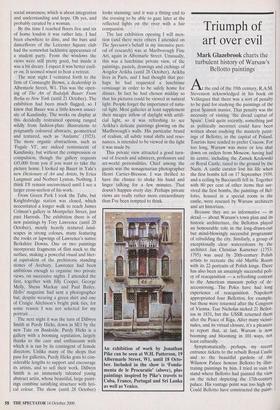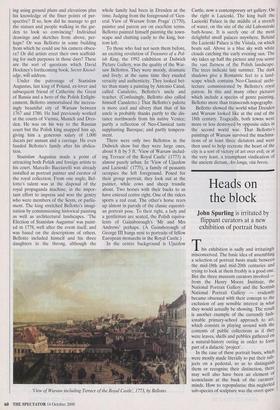Triumph of art over evil
Mark Glazebrook charts the turbulent history of Warsaw's Bellotto paintings
At the end of the 19th century, R.A.M. Stevenson acknowledged in his book on Velazquez that there was a sort of penalty to be paid for studying the paintings of the great Spanish master. That penalty was the necessity of visiting 'the dread capital of Spain'. Until quite recently, something just as politically incorrect could have been written about studying the masterly paint- ings of Bellotto, in the capital of Poland. Tourists have tended to prefer Cracow. For too long, Warsaw was more or less shut down on orders from Moscow, having had its centre, including the Zamek Krolewski or Royal Castle, razed to the ground by the Nazis. A castle curator lost his life when the first bombs fell on 17 September 1939, and a ceiling by Bacciarelli fell in. Together with 80 per cent of other items that sur- vived the first bombs, the paintings of Bel- lotto, housed in a special room in the castle, were rescued by Warsaw architects and art historians.
Because they are so informative — in detail — about Warsaw's town plan and its historic architecture, the Bellottos played an honourable role in the long-drawn-out but mind-blowingly successful programme of rebuilding the city. Similarly, a group of exceptionally clear watercolours by the architect Jan Christian Kametser (1753- 1795) was used by 20th-century Polish artists to recreate the old Marble Room with its 22 portraits of Polish kings. There has also been an amazingly successful poli- cy of reacquisition — a refreshing contrast to the American museum policy of de- accessioning. The Poles have had long experience of reacquisition. Napoleon appropriated four Bellottos, for example, but these were returned after the Congress of Vienna. Tsar Nicholas nicked 21 Bellot- tos in 1831, but the USSR returned them after the Peace of Riga. After many vicissi- tudes, and its virtual closure, it's a pleasure to report that, at last, Warsaw is now booming and blooming in 101 ways, not least culturally.
Symptomatically, perhaps, my recent entrance tickets to the rebuilt Royal Castle and to the beautiful gardens of the Wilanow Palace honour Bellotto by illus- trating paintings by him. I tried in vain to stand where Bellotto had painted the view on the ticket depicting the 17th-century palace. His vantage point was too high up. Could Bellotto have constructed the paint- ing using ground plans and elevations plus his knowledge of the finer points of per- spective? If so, how did he manage to get the statues and people walking in the gar- den to look so convincing? Individual drawings and sketches from above, per- haps? Or was Bellotto in some building from which he could use his camera obscu- ra? Or did artists erect their own scaffold- ing for such purposes in those days? These are the sort of questions which David Hockney's forthcoming book, Secret Knowl- edge, will address.
Under the patronage of Stanislaw Augustus, last king of Poland, ex-lover and subsequent friend of Catherine the Great of Russia and a hero of the Polish Enlight- enment, Bellotto immortalised the increas- ingly beautiful city of Warsaw between 1767 and 1780. He had previously worked at the courts of Vienna, Munich and Dres- den. He was on his way to the Russian court but the Polish king snapped him up, giving him a generous salary of 1,000 ducats per annum and a carriage. He even funded Bellotto's family after his abdica- tion.
Stanislaw Augustus made a point of attracting both Polish and foreign artists to his court, Marcello Bacciarelli was already installed as portrait painter and curator of the royal collection. From one angle, Bel- lotto's talent was at the disposal of the royal propaganda machine, in the impor- tant effort to impress and woo the gentry who were members of the Seym, or parlia- ment. The king stretched Bellotto's imagi- nation by commissioning historical painting as well as architectural landscapes. 'The Election of Stanislaw Augustus' was paint- ed in 1778, well after the event itself, and was based on the descriptions of others. Bellotto included himself and his three daughters in the throng, although the whole family had been in Dresden at the time. Judging from the foreground of 'Gen- eral View of Warsaw from Praga' (1770), painter and patron are on excellent terms. Bellotto painted himself painting the town- scape and chatting easily to the king, bot- tom left.
To those who had not seen them before, an exciting revelation of Treasures of a Pol- ish King, the 1992 exhibition at Dulwich Picture Gallery, was the quality of the War- saw Bellottos. They were moody, dramatic and lively; at the same time they exuded veracity and authenticity. They looked bet- ter than many a painting by Antonio Canal, called Canaletto, Bellotto's uncle and teacher. (Confusingly, Bellotto also called himself Canaletto.) That Bellotto's palette is more cool and silvery than that of his uncle is probably thanks partly to the dis- tance northwards from his native Venice; partly a reflection of Neo-Classical taste supplanting Baroque; and partly tempera- ment.
There were only two Bellottos in the Dulwich show but they were large ones, about 8 ft by 5 ft. 'View of Warsaw includ- ing Terrace of the Royal Castle' (1773) is almost purely urban. In 'View of Ujazdow and Lazienki' (1775), a family of peasants occupies the left foreground. Posed for their group portrait, they look out at the painter, while cows and sheep trundle about. Two horses with their backs to us have entered centre right. One of the riders sports a red coat. The other's horse rears up almost in parody of the classic equestri- an portrait pose. To their right, a lady and a gentleman are seated, the Polish equiva- lents of Gainsborough's 'Mr and Mrs Andrews' perhaps. (A Gainsborough of George III hangs next to portraits of fellow European monarchs in the Royal Castle.)
In the centre background is Ujazdow `View of Warsaw including Terrace of the Royal Castle, 1773, by Bellotto Castle, now a contemporary art gallery. On the right is Lazienki. The king built the Lazienki Palace in the middle of a stretch of water, on the site of the old Lubomirski bath-house. It is surely one of the most delightful small palaces anywhere. Behind the Lazienki Palace is the Vistula, on which boats sail. Above is a blue sky with white clouds catching the early evening sun. The sky takes up half the picture and you sense the vast flatness of the Polish landscape. The trees indicate late summer. The dark shadows give a Romantic feel to a land- scape which contains Neo-Classical archi- tecture commissioned by Bellotto's royal patron. In this and many other pictures which include a species of genre painting, Bellotto more than transcends topography.
Bellotto showed the world what Dresden and Warsaw looked like at the end of the 18th century. Tragically, both towns were more or less destroyed by opposite sides in the second world war. That Bellotto's paintings of Warsaw survived the machina- tions of at least three dictators and were then used to help recreate the heart of the city is a sort of victory of art over evil; or at the very least, a triumphant vindication of the ancient dictum, Ars longs, vita brevis.



















































































 Previous page
Previous page